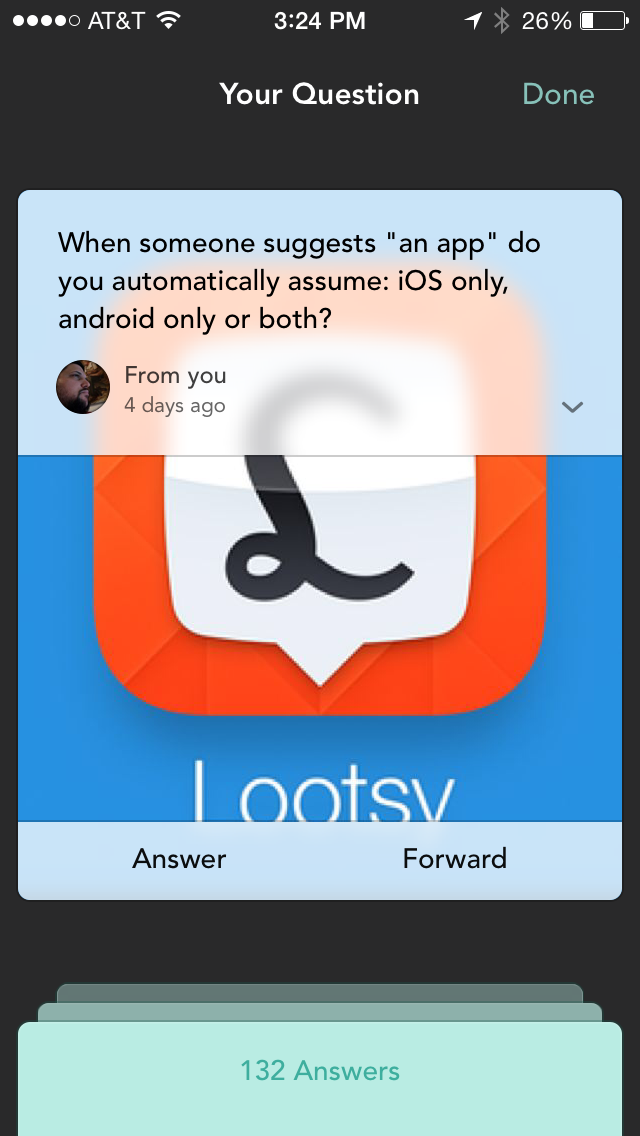Jelly: The User Rope-a-Dope
Rumble in the Jungle / Ali v. Forman
A week or so ago I was talking to Josh Elman about Jelly.
“What do you think?” he asked.
“I dunno. It feels like they are throwing the ‘user rope-a-dope.’”
In competitive situations other than boxing, rope-a-dope is used to describe strategies in which one party purposely puts itself in what appears to be a losing position, attempting thereby to become the eventual victor.
In essence, presenting one thing as a measure of success, when in fact, something else entirely is being targeted.
For the first week or so of using Jelly, I hated it. I saw it as nothing but noise. Silly questions being asked. People trying to be cute, funny or sarcastic in their response. Just trash.
The interface is non-intuitive. Swiping away questions only eliminated them for the session. It wasn’t even clear how to ask a question properly.
But several of my friends were excited about it. Josh was excited about it; Bijan Sabet, someone I had long admired was on their board. Ben Finkel, who was the founder of Fluther, which was a really smart Q&A(ish) platform was someone I was very impressed by the conversations we have had, and of course, Biz Stone (who I don’t know) carried the halo of growing Twitter.
Clearly, I was the idiot, right?
So I kept playing with it.
At first, I just consumed. I looked at the questions being asked, and the answers being given. My consumption pattern was similar to Twitter or Quora in that I used it most often inbetween activity.
As I do when I am spending time with an app, I just used it quietly. I didn’t ask friends what they thought. My friends are mostly in the industry, and are technologists and designers. So I get a lot of UI/UX and functional feedback. Not to say we are an unfeeling bunch, but there is not a lot of discussion around the emotion/community potential of an app. So I don’t ask.
Finally, as the week came to an end, I asked an innocuous question.

132 answers. In a couple of hours. Wow.
And that is the answer. Jelly is not focused on those asking questions. Frankly, the app is built to making asking questions difficult. Take a picture? Draw on it? Try to do something with just text … forget it.
It’s easy to dismiss the difficulty of asking as a way to increase quality, but given the ephemeral nature of the questions (these are not Quora/Wikipedia going to be cited in the WSJ type questions), quantity should matter more than quality. Who cares if you ask banal questions like “what is this statue in the middle of the park?” or “Boxers or Briefs?” Content is content.
But it’s not. The question doesn’t matter. The answers do. The amazing thing about Q&A communities is not in the questions asked, but in the answers given. The quality of answers defines the community. with Quora it is a high brow “show how smart you are,” with Yahoo! Answers it is show off your humor skills.
The excitement around Jelly is based on the speed and volume of answers. People spend more time answering questions than asking them. Yes, many of the answers are horrible. But many aren’t.
So while it would seem that getting folks to ask questions would be the focus of Jelly’s growth and community teams, the truth is the opposite. We, the user, have been rope-a-doped. Jelly doesn’t want our questions. They want our answers.
It’s brilliant. The monetizable action is the answer — brands will pay to be able to engage via answers. They will only be shamed and potentially lose control if the action was asks.
How do I know? Jelly told me.

I asked that question as I started to write this post 20 minutes ago. Of the 15 answers, 14 said “Answerer.” Two indicated that they had asked multiple questions and got zero answers.
Rope-a-Doped.
